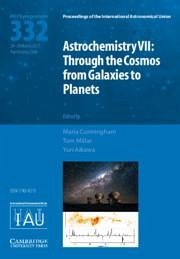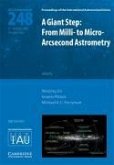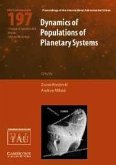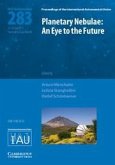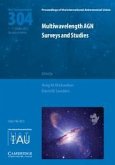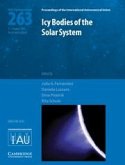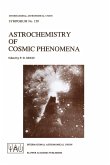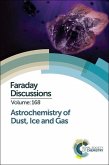Astrochemistry VII (Iau S332)
Through the Cosmos from Galaxies to Planets
Herausgeber: Cunningham, Maria; Aikawa, Yuri; Millar, Tom
Astrochemistry VII (Iau S332)
Through the Cosmos from Galaxies to Planets
Herausgeber: Cunningham, Maria; Aikawa, Yuri; Millar, Tom
- Gebundenes Buch
- Merkliste
- Auf die Merkliste
- Bewerten Bewerten
- Teilen
- Produkt teilen
- Produkterinnerung
- Produkterinnerung
Reviews how observations of organic molecules in space, numerical models and laboratory studies are used to study the Universe's evolution.
Andere Kunden interessierten sich auch für
![A Giant Step: From MILLI- To Micro- Arcsecond Astrometry (Iau S248) A Giant Step: From MILLI- To Micro- Arcsecond Astrometry (Iau S248)]() A Giant Step: From MILLI- To Micro- Arcsecond Astrometry (Iau S248)102,99 €
A Giant Step: From MILLI- To Micro- Arcsecond Astrometry (Iau S248)102,99 €![Dynamics of Populations of Planetary Systems (Iau C197) Dynamics of Populations of Planetary Systems (Iau C197)]() Zoran Knezevic (ed.)Dynamics of Populations of Planetary Systems (Iau C197)85,99 €
Zoran Knezevic (ed.)Dynamics of Populations of Planetary Systems (Iau C197)85,99 €![Planetary Nebulae (Iau S283) Planetary Nebulae (Iau S283)]() Planetary Nebulae (Iau S283)83,99 €
Planetary Nebulae (Iau S283)83,99 €![Multiwavelength Agn Surveys and Studies (Iau S304) Multiwavelength Agn Surveys and Studies (Iau S304)]() Multiwavelength Agn Surveys and Studies (Iau S304)85,99 €
Multiwavelength Agn Surveys and Studies (Iau S304)85,99 €![Icy Bodies of the Solar System (Iau S263) Icy Bodies of the Solar System (Iau S263)]() Icy Bodies of the Solar System (Iau S263)91,99 €
Icy Bodies of the Solar System (Iau S263)91,99 €![Astrochemistry of Cosmic Phenomena Astrochemistry of Cosmic Phenomena]() International Astronomical UnionAstrochemistry of Cosmic Phenomena185,99 €
International Astronomical UnionAstrochemistry of Cosmic Phenomena185,99 €![Astrochemistry of Dust, Ice and Gas Astrochemistry of Dust, Ice and Gas]() Astrochemistry of Dust, Ice and Gas228,99 €
Astrochemistry of Dust, Ice and Gas228,99 €-
-
-
Reviews how observations of organic molecules in space, numerical models and laboratory studies are used to study the Universe's evolution.
Hinweis: Dieser Artikel kann nur an eine deutsche Lieferadresse ausgeliefert werden.
Hinweis: Dieser Artikel kann nur an eine deutsche Lieferadresse ausgeliefert werden.
Produktdetails
- Produktdetails
- Verlag: Cambridge University Press
- Seitenzahl: 462
- Erscheinungstermin: 29. November 2018
- Englisch
- Abmessung: 257mm x 191mm x 18mm
- Gewicht: 862g
- ISBN-13: 9781107192577
- ISBN-10: 1107192579
- Artikelnr.: 51786524
- Herstellerkennzeichnung
- Libri GmbH
- Europaallee 1
- 36244 Bad Hersfeld
- gpsr@libri.de
- Verlag: Cambridge University Press
- Seitenzahl: 462
- Erscheinungstermin: 29. November 2018
- Englisch
- Abmessung: 257mm x 191mm x 18mm
- Gewicht: 862g
- ISBN-13: 9781107192577
- ISBN-10: 1107192579
- Artikelnr.: 51786524
- Herstellerkennzeichnung
- Libri GmbH
- Europaallee 1
- 36244 Bad Hersfeld
- gpsr@libri.de
Opening address
1. Atoms and molecules at high redshifts
2. Ultra-luminous extragalactic chemistry
3. Observations of a hot molecular core in a low metallicity dwarf galaxy
4. The ALMA view of UV-irradiated molecular cloud edges
5. High-temperature chemistry in external galaxies
6. Low metallicity ISM: physical properties of the gas and dust
7. Fire from Ice - massive star birth from infrared dark clouds
8. Tracing the evolution of massive protostars
9. Chemical change in the disk forming region of IRAS 16293-2422 studied with ALMA
10. A molecular outflow-prestellar core interaction in L1689N
11. The excitation and emission spectrum of the hydrogen molecular ion
12. The molecular inventory of diffuse clouds
13. Barnard 1b
14. Astrochemistry of light hydrides with SOFIA
15. Theoretical approaches to surface chemistry
16. Molecule and dust formation in late-type stars
17. Dust formation at cryogenic temperatures
18. Simulations of branched carbon-chain chemistry in star-forming regions
19. The photochemical evolution of the interstellar PAH family
20. Laboratory astrochemistry
21. Exploring molecular complexity in the Galactic Center with ALMA
22. Imaging the water snowline in protostellar envelopes
23. Chemical tracers of dynamics in low-mass protostellar objects
24. Protostellar Interferometric Line Survey (PILS)
25. Herschel observations of molecular emission lines in low- and intermediate-mass evolved stars
26. Interstellar reaction screening via microwave spectral taxonomy
27. Isotopic fractionation in interstellar molecules
28. Insights into astrochemistry - highlights from the Rosetta mission
29. On the origin of O2, N2, and other volatile species in comets
30. ALMA observations of Titan's atmospheric chemistry and seasonal variation
31. The chemical connection between 67P/C-G and IRAS16293
32. Nitrogen fractionation in star-forming regions and primitive Solar System materials
33. Spatially resolved organic chemistry in protoplanetary disks
34. Unveiling the mid-plane temperature and mass distribution in the giant-planet formation zone
35. Zooming in on the physics and chemistry of protoplanetary disks with ALMA
36. Different dust and gas radial extents in protoplanetary disks
37. ALMA detection of gas-phase methanol in a planet-forming disk
38. Measuring gas masses and carbon depletion in young disks
39. Dust in transition disks
40. Nitrogen fractionation in protoplanetary disks from the H13CN/HC15N ratio
41. Models of nitrogen isotope fractionation in protoplanetary disks
42. Chemistry and evolution of the oldest white dwarf planetary systems
43. What does the chemical composition of giant planets tells us about their formation?
44. Chemical characterization of exoplanetary atmospheres
45. JWST: the role of observing facilities in setting the agenda
46. ALMA Band 1 and astrochemistry
47. ALMA
48. Processing of interstellar ices by soft X-rays and swift ions
49. Laboratory measurements of methanol photolysis branching ratios to guide astrochemical models
50. Acetaldehyde and carbonaceous dust
51. Photodestruction of astrophysically relevant ice species
52. Synchrotron X-ray irradiation of N-rich organics
53. Gas phase studies of astrochemical importance
54. Photochemistry and radiation chemistry of cosmic ice analogs of ammonia.
1. Atoms and molecules at high redshifts
2. Ultra-luminous extragalactic chemistry
3. Observations of a hot molecular core in a low metallicity dwarf galaxy
4. The ALMA view of UV-irradiated molecular cloud edges
5. High-temperature chemistry in external galaxies
6. Low metallicity ISM: physical properties of the gas and dust
7. Fire from Ice - massive star birth from infrared dark clouds
8. Tracing the evolution of massive protostars
9. Chemical change in the disk forming region of IRAS 16293-2422 studied with ALMA
10. A molecular outflow-prestellar core interaction in L1689N
11. The excitation and emission spectrum of the hydrogen molecular ion
12. The molecular inventory of diffuse clouds
13. Barnard 1b
14. Astrochemistry of light hydrides with SOFIA
15. Theoretical approaches to surface chemistry
16. Molecule and dust formation in late-type stars
17. Dust formation at cryogenic temperatures
18. Simulations of branched carbon-chain chemistry in star-forming regions
19. The photochemical evolution of the interstellar PAH family
20. Laboratory astrochemistry
21. Exploring molecular complexity in the Galactic Center with ALMA
22. Imaging the water snowline in protostellar envelopes
23. Chemical tracers of dynamics in low-mass protostellar objects
24. Protostellar Interferometric Line Survey (PILS)
25. Herschel observations of molecular emission lines in low- and intermediate-mass evolved stars
26. Interstellar reaction screening via microwave spectral taxonomy
27. Isotopic fractionation in interstellar molecules
28. Insights into astrochemistry - highlights from the Rosetta mission
29. On the origin of O2, N2, and other volatile species in comets
30. ALMA observations of Titan's atmospheric chemistry and seasonal variation
31. The chemical connection between 67P/C-G and IRAS16293
32. Nitrogen fractionation in star-forming regions and primitive Solar System materials
33. Spatially resolved organic chemistry in protoplanetary disks
34. Unveiling the mid-plane temperature and mass distribution in the giant-planet formation zone
35. Zooming in on the physics and chemistry of protoplanetary disks with ALMA
36. Different dust and gas radial extents in protoplanetary disks
37. ALMA detection of gas-phase methanol in a planet-forming disk
38. Measuring gas masses and carbon depletion in young disks
39. Dust in transition disks
40. Nitrogen fractionation in protoplanetary disks from the H13CN/HC15N ratio
41. Models of nitrogen isotope fractionation in protoplanetary disks
42. Chemistry and evolution of the oldest white dwarf planetary systems
43. What does the chemical composition of giant planets tells us about their formation?
44. Chemical characterization of exoplanetary atmospheres
45. JWST: the role of observing facilities in setting the agenda
46. ALMA Band 1 and astrochemistry
47. ALMA
48. Processing of interstellar ices by soft X-rays and swift ions
49. Laboratory measurements of methanol photolysis branching ratios to guide astrochemical models
50. Acetaldehyde and carbonaceous dust
51. Photodestruction of astrophysically relevant ice species
52. Synchrotron X-ray irradiation of N-rich organics
53. Gas phase studies of astrochemical importance
54. Photochemistry and radiation chemistry of cosmic ice analogs of ammonia.
Opening address
1. Atoms and molecules at high redshifts
2. Ultra-luminous extragalactic chemistry
3. Observations of a hot molecular core in a low metallicity dwarf galaxy
4. The ALMA view of UV-irradiated molecular cloud edges
5. High-temperature chemistry in external galaxies
6. Low metallicity ISM: physical properties of the gas and dust
7. Fire from Ice - massive star birth from infrared dark clouds
8. Tracing the evolution of massive protostars
9. Chemical change in the disk forming region of IRAS 16293-2422 studied with ALMA
10. A molecular outflow-prestellar core interaction in L1689N
11. The excitation and emission spectrum of the hydrogen molecular ion
12. The molecular inventory of diffuse clouds
13. Barnard 1b
14. Astrochemistry of light hydrides with SOFIA
15. Theoretical approaches to surface chemistry
16. Molecule and dust formation in late-type stars
17. Dust formation at cryogenic temperatures
18. Simulations of branched carbon-chain chemistry in star-forming regions
19. The photochemical evolution of the interstellar PAH family
20. Laboratory astrochemistry
21. Exploring molecular complexity in the Galactic Center with ALMA
22. Imaging the water snowline in protostellar envelopes
23. Chemical tracers of dynamics in low-mass protostellar objects
24. Protostellar Interferometric Line Survey (PILS)
25. Herschel observations of molecular emission lines in low- and intermediate-mass evolved stars
26. Interstellar reaction screening via microwave spectral taxonomy
27. Isotopic fractionation in interstellar molecules
28. Insights into astrochemistry - highlights from the Rosetta mission
29. On the origin of O2, N2, and other volatile species in comets
30. ALMA observations of Titan's atmospheric chemistry and seasonal variation
31. The chemical connection between 67P/C-G and IRAS16293
32. Nitrogen fractionation in star-forming regions and primitive Solar System materials
33. Spatially resolved organic chemistry in protoplanetary disks
34. Unveiling the mid-plane temperature and mass distribution in the giant-planet formation zone
35. Zooming in on the physics and chemistry of protoplanetary disks with ALMA
36. Different dust and gas radial extents in protoplanetary disks
37. ALMA detection of gas-phase methanol in a planet-forming disk
38. Measuring gas masses and carbon depletion in young disks
39. Dust in transition disks
40. Nitrogen fractionation in protoplanetary disks from the H13CN/HC15N ratio
41. Models of nitrogen isotope fractionation in protoplanetary disks
42. Chemistry and evolution of the oldest white dwarf planetary systems
43. What does the chemical composition of giant planets tells us about their formation?
44. Chemical characterization of exoplanetary atmospheres
45. JWST: the role of observing facilities in setting the agenda
46. ALMA Band 1 and astrochemistry
47. ALMA
48. Processing of interstellar ices by soft X-rays and swift ions
49. Laboratory measurements of methanol photolysis branching ratios to guide astrochemical models
50. Acetaldehyde and carbonaceous dust
51. Photodestruction of astrophysically relevant ice species
52. Synchrotron X-ray irradiation of N-rich organics
53. Gas phase studies of astrochemical importance
54. Photochemistry and radiation chemistry of cosmic ice analogs of ammonia.
1. Atoms and molecules at high redshifts
2. Ultra-luminous extragalactic chemistry
3. Observations of a hot molecular core in a low metallicity dwarf galaxy
4. The ALMA view of UV-irradiated molecular cloud edges
5. High-temperature chemistry in external galaxies
6. Low metallicity ISM: physical properties of the gas and dust
7. Fire from Ice - massive star birth from infrared dark clouds
8. Tracing the evolution of massive protostars
9. Chemical change in the disk forming region of IRAS 16293-2422 studied with ALMA
10. A molecular outflow-prestellar core interaction in L1689N
11. The excitation and emission spectrum of the hydrogen molecular ion
12. The molecular inventory of diffuse clouds
13. Barnard 1b
14. Astrochemistry of light hydrides with SOFIA
15. Theoretical approaches to surface chemistry
16. Molecule and dust formation in late-type stars
17. Dust formation at cryogenic temperatures
18. Simulations of branched carbon-chain chemistry in star-forming regions
19. The photochemical evolution of the interstellar PAH family
20. Laboratory astrochemistry
21. Exploring molecular complexity in the Galactic Center with ALMA
22. Imaging the water snowline in protostellar envelopes
23. Chemical tracers of dynamics in low-mass protostellar objects
24. Protostellar Interferometric Line Survey (PILS)
25. Herschel observations of molecular emission lines in low- and intermediate-mass evolved stars
26. Interstellar reaction screening via microwave spectral taxonomy
27. Isotopic fractionation in interstellar molecules
28. Insights into astrochemistry - highlights from the Rosetta mission
29. On the origin of O2, N2, and other volatile species in comets
30. ALMA observations of Titan's atmospheric chemistry and seasonal variation
31. The chemical connection between 67P/C-G and IRAS16293
32. Nitrogen fractionation in star-forming regions and primitive Solar System materials
33. Spatially resolved organic chemistry in protoplanetary disks
34. Unveiling the mid-plane temperature and mass distribution in the giant-planet formation zone
35. Zooming in on the physics and chemistry of protoplanetary disks with ALMA
36. Different dust and gas radial extents in protoplanetary disks
37. ALMA detection of gas-phase methanol in a planet-forming disk
38. Measuring gas masses and carbon depletion in young disks
39. Dust in transition disks
40. Nitrogen fractionation in protoplanetary disks from the H13CN/HC15N ratio
41. Models of nitrogen isotope fractionation in protoplanetary disks
42. Chemistry and evolution of the oldest white dwarf planetary systems
43. What does the chemical composition of giant planets tells us about their formation?
44. Chemical characterization of exoplanetary atmospheres
45. JWST: the role of observing facilities in setting the agenda
46. ALMA Band 1 and astrochemistry
47. ALMA
48. Processing of interstellar ices by soft X-rays and swift ions
49. Laboratory measurements of methanol photolysis branching ratios to guide astrochemical models
50. Acetaldehyde and carbonaceous dust
51. Photodestruction of astrophysically relevant ice species
52. Synchrotron X-ray irradiation of N-rich organics
53. Gas phase studies of astrochemical importance
54. Photochemistry and radiation chemistry of cosmic ice analogs of ammonia.

